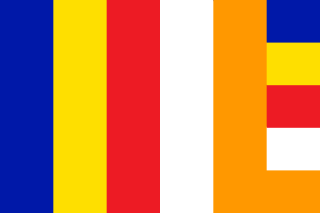Loading AI tools
Universal symbol of Buddhism From Wikipedia, the free encyclopedia
The Buddhist flag is a flag designed in the late 19th century as a universal symbol of Buddhism.[1] The flag's six vertical bands represent the five colors of the aura which Buddhists believe emanated from the body of the Buddha when he attained enlightenment.




The flag was originally designed in 1885 by the Colombo Committee, in Colombo, Ceylon (now Sri Lanka). The committee consisted of Ven. Hikkaduwe Sri Sumangala Thera (chairman), Ven. Migettuwatte Gunananda Thera, Don Carolis Hewavitharana (father of Anagarika Dharmapala), Andiris Perera Dharmagunawardhana (maternal grandfather of Anagarika Dharmapala), Charles A. de Silva, Peter De Abrew, William De Abrew (father of Peter), H. William Fernando, N. S. Fernando and Carolis Pujitha Gunawardena (secretary).[2]
It was first publicly hoisted on Vesak day, 28 May 1885[1] at the Dipaduttamarama, Kotahena, by Ven. Migettuwatte Gunananda Thera.[3] This was the first Vesak public holiday under British rule.[3]
Colonel Henry Steel Olcott, an American journalist, founder and first president of the Theosophical Society, felt that its long streaming shape made it inconvenient for general use. He therefore suggested modifying it so that it was the size and shape of national flags.[1]
In 1889, the modified flag was introduced to Japan by Anagarika Dharmapala and Olcott—who presented it to Emperor Meiji—and subsequently to Burma.[4]
At the 1950 World Fellowship of Buddhists, the flag of Buddhists was adopted as the International Buddhist Flag.[5]
The flag's six vertical bands represent the six colors of the aura which Buddhists believe emanated from the body of the Buddha when he attained Enlightenment:[6][1]
The sixth vertical band, on the fly, is made up of a combination of the five other colors' rectangular bands, and represents a compound of said colors in the aura's spectrum. This new, compound color is referred to as the Truth of the Buddha's teaching or Pabbhassara (lit. 'essence of light').
This section needs additional citations for verification. (October 2018) |
In 1963, the Catholic President of South Vietnam Ngo Dinh Diem invoked a law prohibiting flags other than that of the nation, to ban the Buddhist flag from being flown on Vesak, when Vatican flags had habitually flown at government events. This led to protests, which were ended by lethal firing of weapons, starting the Buddhist crisis.[8]
Seamless Wikipedia browsing. On steroids.
Every time you click a link to Wikipedia, Wiktionary or Wikiquote in your browser's search results, it will show the modern Wikiwand interface.
Wikiwand extension is a five stars, simple, with minimum permission required to keep your browsing private, safe and transparent.